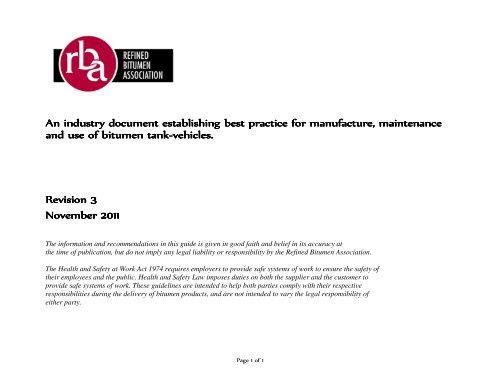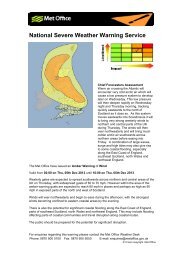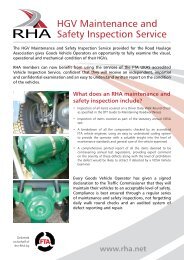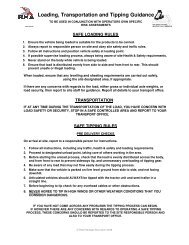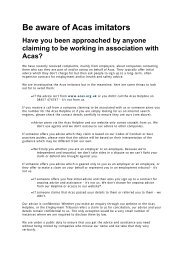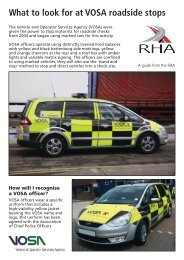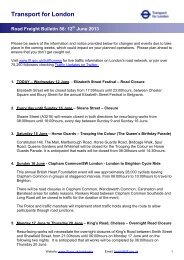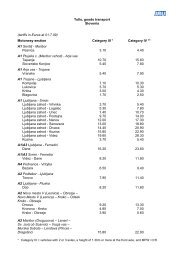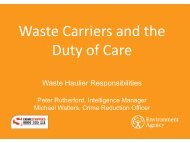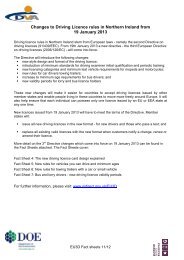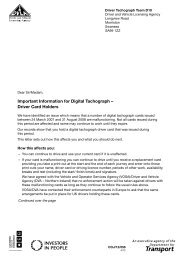RBA best practice for bitumen tank-vehicle operations 2011
RBA best practice for bitumen tank-vehicle operations 2011
RBA best practice for bitumen tank-vehicle operations 2011
Create successful ePaper yourself
Turn your PDF publications into a flip-book with our unique Google optimized e-Paper software.
An industry document establishing <strong>best</strong> <strong>practice</strong> <strong>for</strong> manufacture, maintenanceand use of <strong>bitumen</strong> <strong>tank</strong>-<strong>vehicle</strong>s.Revision 3November <strong>2011</strong>The in<strong>for</strong>mation and recommendations in this guide is given in good faith and belief in its accuracy atthe time of publication, but do not imply any legal liability or responsibility by the Refined Bitumen Association.The Health and Safety at Work Act 1974 requires employers to provide safe systems of work to ensure the safety oftheir employees and the public. Health and Safety Law imposes duties on both the supplier and the customer toprovide safe systems of work. These guidelines are intended to help both parties comply with their respectiveresponsibilities during the delivery of <strong>bitumen</strong> products, and are not intended to vary the legal responsibility ofeither party.Page 1 of 1
CONTENTS1. Vehicle Design1.1. Vessel & Structure1.1.1. Manway lids1.1.2. Secondary emergency access points1.1.3. Foot valves1.1.4. Secondary valves1.1.5. Pressure/Vacuum Relief Valves1.1.6. Manway walk plat<strong>for</strong>ms1.1.7. Venting systems1.1.8. Temperature gauges1.1.9. Pressure/vacuum gauges1.1.10. Airline splitter systems1.1.11. Hose security systems1.2. Running gear1.2.1. Stability systems1.2.2. Weight cells1.3. Ancillary equipment1.3.1. Emergency spillage intervention/containment equipment1.3.2. Emergency stop buttons1.3.3. Emergency release valve on outlet1.3.4. Brake interlock/sequential valve systems1.3.5. Outlet flange anti-spray protection systems1.3.6. Delivery and uplift hoses1.3.7. Reversing aidsPage 2 of 2
1.3.8. Amber beacons1.3.9. Fire extinguishers, self standing warning devices and wheel chocks2. Maintenance2.1. Vessel servicing2.2. PVRV servicing2.3. Outlet and/or hose bolts2.4. Hose servicing3. Use3.1. Commissioning3.2. Maximum loading volumes3.3. Out of service <strong>bitumen</strong> <strong>tank</strong>s3.4. Re-entry to service of <strong>bitumen</strong> <strong>tank</strong>s3.5. Procedure loading3.6. Customer <strong>tank</strong> uplifts3.7. Vehicle to <strong>vehicle</strong> transfers3.8. Removing hazchem panels3.9. End of life de-commissioningPage 3 of 3
1. Vehicle Design ( In accordance with current ADR regulations )1.1. Vessel & Structure1.1.1. Manway lidsApertures designed <strong>for</strong> man entry or product loading should be 500mm diameter, set astride the vessel on thecentre line, at the highest possible point. The securing system should not place undue manual handling stresses onthe operative. The lid should be of the lightest possible safe design specification without any valve arrangements setwithin it. Manway seals should be capable of resisting temperatures of at least 250 o C and capable of resistingcompression. A safety bolt must be fitted and this should be opposite the hinge or swivel point.1.1.2. Secondary emergency access pointsAn emergency vessel access point should be set astride the vessel on the centre line, at the highest possible point tothe rear of the vessels last baffle/surge plate to ensure uplift of the entire product is viable without needing toaccess the outlet. The aperture should be a bolted flange face with a diameter of at least 150mm. The flanges shouldhave a graphite gasket and the nuts must have a locking system which is capable of resisting at least 250 o C. Theaccess point should be covered to protect operatives from personnel injury and to prevent a core building up in theaperture.1.1.3. Foot valvesFoot valves should be capable of being gradually opened and closed even when cold. Seals should be capable ofresisting temperatures of at least 250 o C.1.1.4. Secondary valvesSecondary valves should be metallic seated, or capable of resisting temperatures of at least 250 o C, andpneumatically powered. They should be integrated into an emergency shut down system with a closure rate notexceeding one second. All valves should be fitted with a visual indicator to clarify its mechanical position.1.1.5. Pressure/Vacuum Relief ValvesTwo separate relief valves on the centre line, at the highest possible point capable of resisting temperatures of atleast 250 o C. They should be protected to prevent external contamination from the product when loading. Theyshould be fitted into the vessel without any internal pipe work and minimal external pipe work. If anti-surgebaffling is fitted the distance between the vessel aperture and the baffling should not be too close. Good <strong>practice</strong>would be to fit a relief valve with a manual (pressure/vacuum) release button.1.1.6. Manway walk plat<strong>for</strong>msManway walk plat<strong>for</strong>ms should surround the manway lid(s) on all sides and be at least 450mm wide. They shouldbe flat high grip (single level) surfaces which are level with the ground not the slope of the <strong>tank</strong>-<strong>vehicle</strong>. WherePage 4 of 4
ground operated air inlet/outlet valves are situated near the manway lid. Good <strong>practice</strong> would be to protect themby a lid which is ideally part of the walkway.1.1.7. Venting systemsAir inlet valves should be capable of safely operating with ground based pumps that can operate at 25mt speeds orabove. These valves should ideally be interlocked to the brakes, so that product cannot be released unless the <strong>tank</strong><strong>vehicle</strong>sbrakes are applied, and the vessel product outlet. Air outlet valves should be capable of releasing morepressure than is capable of being created by the tractive unit or belly compressor and ideally will discharge downbelow the belly of the <strong>tank</strong>-<strong>vehicle</strong>.1.1.8. Temperature gaugesTemperature gauges on <strong>bitumen</strong> <strong>tank</strong>-<strong>vehicle</strong>s are designed primarily <strong>for</strong> the reference of the operator to establishif the product is within a reasonable temperature to discharge the load. The gauges do not provide an accuratemeasure of the load’s temperature <strong>for</strong> qualitative purposes. The gauges should be calibrated from an externalcalibrated gauge whilst still within the <strong>tank</strong>-<strong>vehicle</strong>. The exact methodology of re-calibration should be agreed withthe <strong>tank</strong> manufacturer and the instrumentation supplier, however, the point of testing should be very close to thethermometer location to ensure accuracy.1.1.9. Pressure/vacuum gaugesThey should be situated in the operatives work station and the readings should be taken as a general reference only.1.1.10. Airline splitter systemsThe splitter line should be the same diameter as the airline pipe work and be of sectional construction <strong>for</strong> ease ofremoval <strong>for</strong> cleaning. The valve should be pneumatically powered and brake interlocked.1.1.11. Hose security systemsWhere two or more hoses are to be located within the same tray the width must be sufficient to accommodateboth on the bottom of the tray. Trays should be fitted with adequate restraints, one per end plus one in the middle,sufficient to hold the total hose weight by a factor of two. The restraints should not become unserviceable throughpersistent contact with the product. The tray should be capable of containing product leakage from the hoseswhilst still retaining the ability to release rain water.1.2. Running gear1.2.1. Stability systemsPage 5 of 5
Stability systems should be fitted.1.2.2. Weight cellsWherever possible the <strong>tank</strong>-<strong>vehicle</strong> should be fitted with a simple onboard weighing system to provide basicfeedback to the driver about the amount of product left onboard when discharging.1.3. Ancillary equipment1.3.1. Emergency spillage intervention/containment equipmentAny items required by the current ADR regulations should be fitted on the <strong>tank</strong>-<strong>vehicle</strong> and have adequate meansof being secured. The spill box should be suitable <strong>for</strong> dealing with a <strong>bitumen</strong> incident.1.3.2. Emergency stop buttonsEmergency stop buttons should be located one at each corner to close the vessel in an emergency. They should beclearly visible with adequate markings to identify them to non-users.1.3.3. Emergency release valve on outletOutlets should be equipped with a means of releasing product and residual pressure should the method ofdischarge fail whilst product remains within the delivery hose. Ideally this valve will be self cleaning and easilyoperated. It shall not be used <strong>for</strong> sampling unless specifically designed and authorised <strong>for</strong> such. It will ideally betagged with a seal to identify potential misuse.1.3.4. Brake interlock/sequential valve systemsThe <strong>tank</strong>-<strong>vehicle</strong> should be brake interlocked to prevent movement whilst either the inlet, or outlet, are in a partialor fully open position. The brake interlock system should also be speed sensed to prevent activation whilst travellingin excess of 7kph. Good <strong>practice</strong> would be to utilise sequential valves.1.3.5. Outlet flange anti-spray protection systemsThe outlet flange should be protected by a shroud to ensure any spray is deflected down and away from theoperative and the <strong>tank</strong>-<strong>vehicle</strong>.1.3.6. Delivery and uplift hosesPage 6 of 6
Hoses must be designed to enable the safe discharge of <strong>bitumen</strong> products from the delivery <strong>tank</strong>-<strong>vehicle</strong> intostorage. Bitumen is either discharged using air pressure or a ground based pump. The following criteria must beconsidered when specifying <strong>bitumen</strong> hoses:1.3.6.1. A product temperature of up to 250 o C.1.3.6.2. A normal operating pressure of 2.2 bar g (32 psig) but a maximum initial test pressure of 10 bar g (145 psig).1.3.6.3. A delivery flange at each end with a minimum thickness of 20mm.1.3.6.4. All bolts <strong>for</strong> connecting the hose to the customer’s flange must be <strong>for</strong>ged with a long nut and thick dome washers.To manage the <strong>bitumen</strong> hoses satisfactorily it’s essential that each hose assembly is marked with a uniqueidentification number and date of manufacture or test expiry date, as a minimum. This identification should be insuch a manner and place that it cannot be lost or removed and is easily visible. The manufacturer should retainrecords of the construction method and demonstrate full component part traceability <strong>for</strong> each hose. Operators ofthe hoses should hold a certificate of test <strong>for</strong> each hose in use.Hoses should be so constructed that they af<strong>for</strong>d some protection from latent heat immediately following a deliveryand they have some <strong>for</strong>m of carry handle to reduce MHO risks to the operative.1.3.7. Reversing aidsCCTV system cameras should be fitted at least 1 metre from the ground level angled to look down as opposed tostraight back. They should be capable of working in most weather and lighting conditions to ensure effectivenessduring routine <strong>operations</strong>. Where they’re RF linked the operator should de-conflict the band width with anydelivery sites that also use RF systems.Proximity sensors are recommended and should ideally be a stand alone variant with lighting arms fitted to eachside of the rear of the <strong>tank</strong>-<strong>vehicle</strong>, both easily visible by the driver when the <strong>tank</strong>-<strong>vehicle</strong> is in straight alignmentwith the tractive unit.Reversing alarms should be of the broad band variety with a rating of at least 97dB (A) and fitted to the rear of the<strong>tank</strong>-<strong>vehicle</strong>, facing to the rear. Ideally no surface of the <strong>tank</strong>-<strong>vehicle</strong> should reflect noise back.1.3.8. Amber beaconsThe tractive unit and the <strong>tank</strong>-<strong>vehicle</strong> should be fitted with at least one amber beacon, mounted at the highestpoints of each <strong>vehicle</strong>, unless this gives rise to risk of them striking the loading gantries or other associated framework. The <strong>tank</strong>-<strong>vehicle</strong>’s beacon should be mounted at the rear, immediately in front of the rear dome, and visibleto 360 degrees. They both should be single switched from the tractive unit.1.3.9. Fire extinguishers, self standing warning devices and wheel chocks.Page 7 of 7
Fire fighting devices should be fitted to the nearside of the <strong>tank</strong>-<strong>vehicle</strong> in a cabinet ideally holding two 6kg drypowder extinguishers. Three or more reflective jacketed cones should also be fitted to the nearside <strong>for</strong> use inroadside breakdowns. Chocks should be accessible from the nearside although may be fitted to the cross chassis barbetween the <strong>tank</strong>-<strong>vehicle</strong>s landing legs.2. Maintenance2.1. Vessel servicingA written scheme is required <strong>for</strong> mandatory testing although due regard should be af<strong>for</strong>ded to inspect, service ortest the vessel and its associated ancillary valves/pipe work and equipment in respect to the age of the <strong>tank</strong>-<strong>vehicle</strong>and/or the operating conditions. Foot valves should be removed, cleaned and repacked be<strong>for</strong>e test.2.2. PVRV servicingRelease valves are an integral safety feature of a <strong>bitumen</strong> <strong>tank</strong>-<strong>vehicle</strong> and should be removed, cleaned and benchtested on a regular basis within the time scale established in the operators’ written scheme – the ideal periodshould not exceed 18 months. Whenever a valve is removed the refitting of the valve, or its replacement, must befollowed by a vessel leakproofness (soapy water) test.2.3. Outlet and/or hose boltsBolts shall be replaced no less frequently than the hose assemblies they connect to. A system should be in place toregularly inspect the bolts <strong>for</strong> defect and replace as necessary. Bolts should be <strong>for</strong>ged and of a high standard andnot replaced with a generic bolt from a contractor or maintenance agent stock. Good <strong>practice</strong> would be to replacethem annually.2.4. Hose servicingHose assemblies should be subject to a minimum twelve monthly re-test or removed from service. The hose shallbe thoroughly cleaned prior to inspection. Cleaning is carried out by heating the flex with steam at 160ºC whilstthe flex is held with one end lower than the other, preferably vertically, <strong>for</strong> a minimum of 1 hour, or until all excess<strong>bitumen</strong> has run out, (after 4 hours remaining <strong>bitumen</strong> can be ignored). An alternative or optional additionalcleaning can take place by using a solvent wash e.g. a heated kerosene bath. After cleaning the hose assembly, visualchecks can then be carried out.2.4.1. Leak testing must always be carried out when the hose is hot by introducing steam (or hot fluid at a minimum100ºC), gently until a minimum pressure of 4.1 bar g (60 psig) is reached. The pressure should be maintained <strong>for</strong> aminimum of 5 minutes, preferably 15 minutes, after reaching the desired pressure.In the case of a new hose or where the structure of the hose has been altered the test pressure should be taken upto 10 bar g ( 145 psig ).Page 8 of 8
3. Use3.1. CommissioningThe vessels should be heated to 80 o C <strong>for</strong> at least twenty four hours immediately prior to their first load. Thenfollow the re-entry to service requirements.3.2. Maximum loading volumesBitumen <strong>tank</strong>-<strong>vehicle</strong>s should not be volumetrically filled to more than 95% of their water capacity except inemergency situations. Each <strong>tank</strong>-<strong>vehicle</strong> should be clearly marked with their water capacity in litres on at least onedome preceded or followed by, ‘water capacity.’ Where an operator also elects to annotate the <strong>tank</strong>-<strong>vehicle</strong> with asafe working capacity this should also be clearly marked and fully explained (SWC 31000 litres / 28.5 tonnes SWC)to ensure driver, loading point and regulatory authority staff are clear of its meaning.3.3. Out of service <strong>bitumen</strong> <strong>tank</strong>sMobile storage <strong>tank</strong>s, <strong>tank</strong>-<strong>vehicle</strong>s, demountable <strong>tank</strong>s and <strong>tank</strong>-containers <strong>for</strong> the storage of bituminous productsshould have their product identification labels, placards or markings removed following their removal from serviceto ensure they can be readily identified as not in service and, if necessary, additional labelling, placarding ormarkings affixed to at least one appropriate side to identify any current hazard (<strong>tank</strong> entry etc).Wherever possible the aperture used to fill a <strong>tank</strong> should be closed or secured against mistaken filling – where thisis not possible a label, placard or marking shall be affixed in an appropriate position, or positions, to in<strong>for</strong>m theoperative of the dangers to filling the <strong>tank</strong>.3.4. Re-entry to service of <strong>bitumen</strong> <strong>tank</strong>sStatic storage <strong>tank</strong>s, mobile storage <strong>tank</strong>s, <strong>tank</strong>-<strong>vehicle</strong>s, demountable <strong>tank</strong>s and <strong>tank</strong> containers <strong>for</strong> the storage ofbituminous products should have a suitable system <strong>for</strong> the decommission, alteration, service, renovation andsubsequent re-entry into service following contamination from the following products:3.4.1. Water; or3.4.2. Solutions containing water; or3.4.3. Substances or solutions containing flammable liquids.Prior to re-entry into service the operator of the mobile storage <strong>tank</strong>s, <strong>tank</strong>-<strong>vehicle</strong>s, demountable <strong>tank</strong>s and <strong>tank</strong>containers shall ensure the vessel is free from a ‘free surface’ of water, or a solution containing water, or aflammable liquid or atmosphere. This may be done by:Page 9 of 9
3.4.4. Heating the vessel by applying heated air through the manway lids, loading lids, <strong>tank</strong> inlets or any otherappropriate aperture; or3.4.5. Heating the vessel by applying heat from a steam or oil coil fitted to the vessel outer structure or interior space;3.4.5.1. Where water is the main hazard; or3.4.6. Any other means as recognized by industry as being suitable and sufficient; where a flammable liquid was present.The operator shall verify by visual inspection or strict process management that there is no free surface of unsafeliquid or explosive atmosphere and that the <strong>tank</strong> is safe to re-enter service. A certificate of status should becompleted and retained by the operator <strong>for</strong> 12 months from the point of re-entry into service 1 . The certificateshould be produced on request to any person, company or authority body, with due cause to verify the status ofthe <strong>tank</strong>.3.5. Procedure loadingEach operator will maintain a written scheme <strong>for</strong> the safe re-entry of a <strong>bitumen</strong> <strong>tank</strong> into service which includes amethod <strong>for</strong> procedure loading on the first load. This method should include the following steps:3.5.1. The operator of the <strong>tank</strong> will declare to the filler of the <strong>tank</strong> the status and provide on request a copy of thecertificate of status 2 ; and3.5.2. Load in element splits which are compliant to the following protocol:3.5.2.1. First element shall not exceed 10% of the <strong>tank</strong>s safe working capacity; and3.5.2.2. Second and subsequent elements shall not exceed 25% of the <strong>tank</strong>s safe working capacity; and3.5.3. Load splits shall not occur be<strong>for</strong>e a period of at least 10 minutes from the last split;3.5.4. A written record shall be kept with the certificate of status detailing the following items:3.5.4.1. Loading operatives name and company employee number; and3.5.4.2. Location, date and time of loading; and3.5.4.3. Element sizes; and3.5.4.4. Timings between elements; and3.5.4.5. Any other details as applicable to the scheme; and1See Fig 1 <strong>for</strong> a template document2Where this is a <strong>tank</strong>-<strong>vehicle</strong> or <strong>tank</strong> container the loading refinery management will be considered to be the filler.Page 10 of 10
3.5.5. The <strong>tank</strong> shall be affixed with labels, placards or markings that are compliant with prevailing legislation or <strong>best</strong><strong>practice</strong> <strong>for</strong> the product.3.6. Customer <strong>tank</strong> upliftsEach supplier shall compile a detailed safe working <strong>practice</strong> <strong>for</strong> uplifting product from their Customers storage<strong>tank</strong>s. In general the guidance laid down in the Code of Practice should be adhered to. The total volumetricquantity of the product to be uplifted should not exceed 90% of the receiving (<strong>tank</strong>-<strong>vehicle</strong>) vessels water capacity.3.7. Vehicle to <strong>vehicle</strong> transfersVehicle transfers should be undertaken by means of a vacuum transfer wherever possible. The total volumetricquantity of the product to be moved should not exceed 90% of the receiving (<strong>tank</strong>-<strong>vehicle</strong>) vessels water capacity.One operative should be designated as the person in overall charge of the operation. The immediate area of thetransfer should, as far as reasonably practicable, meet the guidelines set out in the Code of Practice.3.8. Removing hazchem panelsRemoval of hazchem panels within the UK is not usually undertaken, however, when done so the operator shouldhave a systematic written process to cover this. Tank-<strong>vehicle</strong>s being removed from service <strong>for</strong> periods over a weekshould have their hazchem panels removed. Removal of hazchem panels to facilitate movement of the <strong>tank</strong>-<strong>vehicle</strong>by drivers not holding a valid ADR vocational training certificate is permissible (subject to above process), althoughnot recommended.3.9. End of life de-commissioningWhere a <strong>tank</strong>-<strong>vehicle</strong> is to be scrapped and not sold on <strong>for</strong> continued use each operator should have detailedprocedures <strong>for</strong> mitigating any subsequent risk of environmental contamination from the residue left within the<strong>tank</strong>-<strong>vehicle</strong>s vessel.Page 11 of 11
Fig 1 – Certificate of StatusCertificate of StatusBitumen <strong>tank</strong>-<strong>vehicle</strong>is declared serviceable following: Inspection only Inspection and Service Routine Maintenance Component strip and rebuild (ancillary equipment) Component strip and rebuild (product vessel and fittings) Water/Flammable liquid contaminated state (please specify)&Any work was completed in accordance with prescribed procedures using the correct materials andmanufacturers recommended parts and equipment. All tools and equipment have been removed fromthe vessel. The <strong>tank</strong> is now free from defects and fit <strong>for</strong> service.OR Specified repair onlyOnly those items identified in the defect process have been made serviceable, and further checksshould be undertaken by the operator to ensure the <strong>tank</strong> and fittings are fit to re-enter service.Signed:Name:Date:Page 12 of 12


